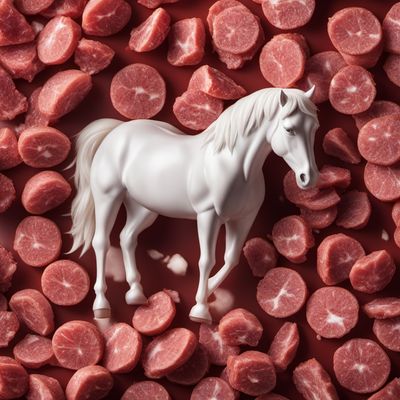
Ingredient
Goat meat, dried
The Savory Delicacy
Dried goat meat is characterized by its rich, gamey flavor and tender, slightly chewy texture. The meat is lean and low in fat, making it a healthier alternative to other red meats. It is often used in stews, curries, and soups, where the slow cooking process helps to tenderize the meat and enhance its natural flavors.
Origins and history
The consumption of goat meat dates back thousands of years and is deeply rooted in various cultures. It is particularly popular in regions where goats are abundant and well-suited to the local climate, such as the Middle East, Africa, and parts of Asia. Goat meat is highly valued for its versatility, nutritional value, and distinct flavor.
Nutritional information
Dried goat meat is a good source of high-quality protein, essential amino acids, iron, and vitamin B12. It is also lower in calories and fat compared to other red meats, making it a healthier option for those watching their dietary intake.
Allergens
Individuals with allergies to other meats, such as beef or lamb, may also be allergic to goat meat. It is recommended to consult with a healthcare professional if you suspect an allergy or have any concerns.
How to select
When selecting dried goat meat, look for cuts that are dark red in color, with a firm texture and minimal fat. The meat should not have any off-putting odors or signs of spoilage. If possible, choose meat from reputable sources that follow proper hygiene and animal welfare practices.
Storage recommendations
To maintain the quality of dried goat meat, store it in a cool, dry place, away from direct sunlight. It is best to keep it in an airtight container or vacuum-sealed packaging to prevent moisture and air exposure, which can lead to spoilage. Proper storage can help extend the shelf life of the meat.
How to produce
Raising goats for meat production requires adequate space, proper nutrition, and access to clean water. They can be raised on pasture or in a barn, depending on the available resources. It is important to provide them with a balanced diet that includes a mix of forage, grains, and minerals. Regular veterinary care is also essential to ensure the health and well-being of the animals.
Preparation tips
Dried goat meat can be used in a variety of dishes and cuisines. It is commonly used in stews, curries, and soups, where the slow cooking process helps to tenderize the meat and infuse it with flavors. The meat can also be marinated and grilled, resulting in a delicious and succulent dish. In some cultures, dried goat meat is ground into a powder and used as a seasoning or added to sausages and meatballs.
Substitutions
Beef or lamb can be used as substitutes for dried goat meat, although they may have a slightly different flavor and texture. Alternatively, for vegetarian options, mushrooms or tofu can be used to mimic the meaty texture and add depth to dishes.
Culinary uses
Dried goat meat is a staple in many cuisines around the world. It is commonly used in Middle Eastern, African, and Asian dishes, such as biryanis, tagines, and curries. It is also a popular ingredient in traditional Mexican and Caribbean cuisine, where it is used in dishes like barbacoa and goat stew.
Availability
Dried goat meat is commonly available in regions where goat farming is prevalent, such as the Middle East, Africa, and parts of Asia. It can also be found in specialty meat markets or ethnic grocery stores in other parts of the world.


